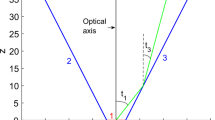Abstract
The classical Monte Carlo ray tracing is a powerful technique for modeling almost all effects in geometric optics; however, it can be prohibitively slow in many cases, such as generation of images seen by an objective or camera with a point aperture. For this reason, numerous modifications of this technique are used, among which is the bidirectional stochastic ray tracing with photon maps. A drawback of all stochastic methods is the undesirable noise. The noise level, i.e., the variance of the pixel luminance calculated for one iteration step, depends on various parameters, such as the number of rays traced from the light source and from the camera, the method of merging their trajectories, the integration sphere radius, etc. The choice of the optimal parameters makes it possible to minimize the noise level for the given computation time. This is the topic of the current paper. It is shown that the variance of the pixel luminance is the sum of three functions scaled by the reciprocal of the number of rays tracedfrom the light source and from the camera, where the functions themselves are independent on the number of rays. Therefore, given these functions, one can predict the noise for any number of rays and thus find the optimal set of parameters. The calculation of these functions based on the data obtained by ray tracing is a nontrivial problem. The paper proposes a practical method for their calculation, and demonstrates that a single such calculation is able to predict the variance for an arbitrary number of rays. Therefore, the noise can be minimized due to the optimal choice of the number of rays.




Similar content being viewed by others
REFERENCES
Zhdanov, D.D., Galaktionov, V. A., Voloboy, A.G., Zhdanov, A.D. Garbul’, A.A., Potemin, I.S., and Sokolov, V. G., Photorealistic rendering of images formed by augmented reality optical systems, Program. Comput. Software, 2018, vol. 44, no. 4, pp. 213–224. https://doi.org/10.1134/S0361768818040126
Sik, M. and Krivanek, J., Survey of Markov chain Monte Carlo methods in light transport simulation, IEEE Trans. Visual. Comput. Graph., 2018, vol. 26, no. 4, pp. 1821–1840.
Pharr, M. and Humphreys, G., Physically Based Rendering: From Theory to Implementation, San Francisco: Morgan Kaufmann, 2010, 2nd ed.
Dodik, N., Implementing probabilistic connections for bidirectional path tracing in the Mitsuba Renderer, Sep. 2017. https://www.cg.tuwien.ac.at/research/publications/2017/dodik-2017-pcbpt/.
Jensen, H.W. and Christensen, P., High quality rendering using ray tracing and photon mapping, ACM SIGGRAPH 2007 Courses, Ser. SIGGRAPH'07. 2007, New York: ACM, 2007. https://doi.org/10.1145/1281500.1281593
Veach, E., A dissertation: Robust Monte-Carlo methods for light transport simulation, 1997. http://graphics.stanford.edu/papers/veach_thesis/thesis.pdf.
Vorba, J., Bidirectional photon mapping, Proc. of CESCG 2011: The 15th Central European Seminar on Computer Graphics, Prague: Charles University, 2011, pp. 25–32. https://cgg.mff.cuni.cz/~jaroslav/papers/2011-bdpm/vorba2011-bdpm.pdf.
Ershov, S.V., Zhdanov, D.D., and Voloboy, A.G., Estimation of noise in calculation of scattering medium luminance by MCRT, Math. Montisnigri, 2019, vol. XLV, pp. 60–73.
Georgiev, I., Krivánek, J., Davidovic, T., and Slusallek, P., Light transport simulation with vertex connection and merging, ACM Trans. Graph. 2012, vol. 31, no 6, pp. 192:1–192:10. https://doi.org/10.1145/2366145.2366211
Hachisuka, T., Pantaleoni, J., and Jensen, H.W., A path space extension for robust light transport simulation, ACM Trans. Graph. 2012, vol. 31, pp. 191:1–191:10.
Ershov, S.V. and Voloboy, A.G., Calculation of MIS weights for bidirectional path tracing with photon maps in presence of direct illumination, Math. Montisnigri, 2020, vol. XLVIII, pp. 86–102.
Sbert, M., Havran, V., and Szirmay-Kalos, L., Multiple importance sampling revisited: Breaking the bounds, EURASIP J. on Advances Signal Proc., 2018, vol. 15, pp. 1–15.
Hachisuka, T. and Jensen, H.W., Stochastic progressive photon mapping, ACM SIGGRAPH Asia 2009 Papers, 2009, pp. 141:1–141:8. https://doi.org/10.1145/1661412.1618487
Ershov, S.V., Birukov, E.D., and Voloboy, A.G., Efficient calculation of optimal weights of multiple importance sampling in the bidirectional ray tracing with photon maps, Preprint of the Keldysh Institute of Applied Mathematics, Russ. Acad. Sci., Moscow, 2020, no. 107, p. 22. https://doi.org/10.20948/prepr-2020-107
Author information
Authors and Affiliations
Corresponding author
Additional information
Translated by A. Klimontovich
Rights and permissions
About this article
Cite this article
Ershov, S.V., Birukov, E.D., Voloboy, A.G. et al. Noise Dependence on the Number of Rays in Bidirectional Stochastic Ray Tracing with Photon Maps. Program Comput Soft 47, 194–200 (2021). https://doi.org/10.1134/S036176882103004X
Received:
Revised:
Accepted:
Published:
Issue Date:
DOI: https://doi.org/10.1134/S036176882103004X




